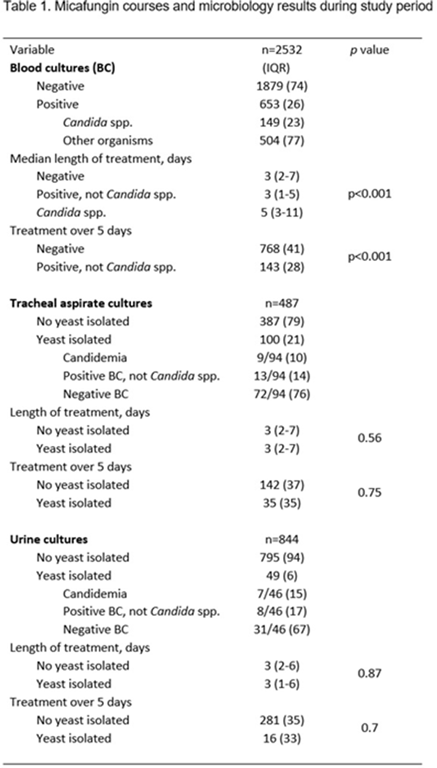No CrossRef data available.
Article contents
Identification of Potentially Unnecessary Micafungin Use Patterns: Opportunities for Antifungal Stewardship Interventions
Published online by Cambridge University Press: 29 July 2021
Abstract
Background: Echinocandins are used as first-line therapy for suspected and confirmed Candida spp, and its indiscriminate use may drive selection for echinocandin resistance. We evaluated patterns of use of micafungin to identify opportunities for antifungal stewardship. Methods: We identified all micafungin completed orders and microbiological test result data from July 2018 to November 2020 among hospitalized patients in Barnes-Jewish Hospital. Continuous micafungin courses with <48 hours of interruption were considered independent courses. We evaluated micafungin use in 3 scenarios in which its use may be unnecessary: (1) patients with blood cultures negative for Candida spp, (2) patients with recovery of yeast or Candida spp from tracheal aspirates, and (3) patients with recovery of yeast or Candida spp from urine cultures. We only included micafungin courses if they were initiated within 5 days of blood culture collection or up to 4 days after tracheal or urine culture collection to account for incubation and decision to initiate treatment. Results: We found 3,381 micafungin courses in 3,287 admissions. Of these, 2,532 courses had blood culture collection around micafungin initiation and were included in the first analysis: 1,879 (74%) were negative, 149 (6%) had Candida spp isolated in the blood, and 504 (20%) had positive blood cultures for other organisms. Micafungin was given for a median duration of 3 days (IQR, 2–7) to those with negative blood cultures and for 3 days (IQR, 1–5) to those with positive blood cultures without candidemia (p < 0.001), and prolonged durations of more than 5 days was seen in 768/1879 (41%) and 143/504 (28%) of courses, respectively (p <0.001). A total of 487 micafungin courses were initiated after tracheal aspirate culture collection. Those with yeast isolated (n = 100, 21%) received similar micafungin duration compared to those that had no yeast isolated [3 (2-7 IQR) vs. 3 (2-7) days, respectively; p = 0.56). Finally, a total of 844 micafungin courses started after urine culture collection. A total of 49 (6%) had yeast isolated from the urine and treatment duration was similar to those that did not [3 (1-6 IQR) vs. 3 (2-6) days, respectively; p = 0.87). Conclusions: Echinocandin treatment courses did not differ when a yeast was identified from a tracheal isolate or urine specimen. However, a substantial proportion of treatment courses were prolonged in those with negative Candida spp in the blood, suggesting opportunities for antifungal stewardship interventions.
Funding: No
Disclosures: None
Table 1.
- Type
- Antibiotic Stewardship
- Information
- Antimicrobial Stewardship & Healthcare Epidemiology , Volume 1 , Issue S1: SHEA Spring 2021 Abstracts , July 2021 , pp. s32 - s33
- Creative Commons
- This is an Open Access article, distributed under the terms of the Creative Commons Attribution licence (http://creativecommons.org/licenses/by/4.0/), which permits unrestricted re-use, distribution, and reproduction in any medium, provided the original work is properly cited.
- Copyright
- © The Author(s), 2021. Published by Cambridge University Press on behalf of The Society for Healthcare Epidemiology of America


